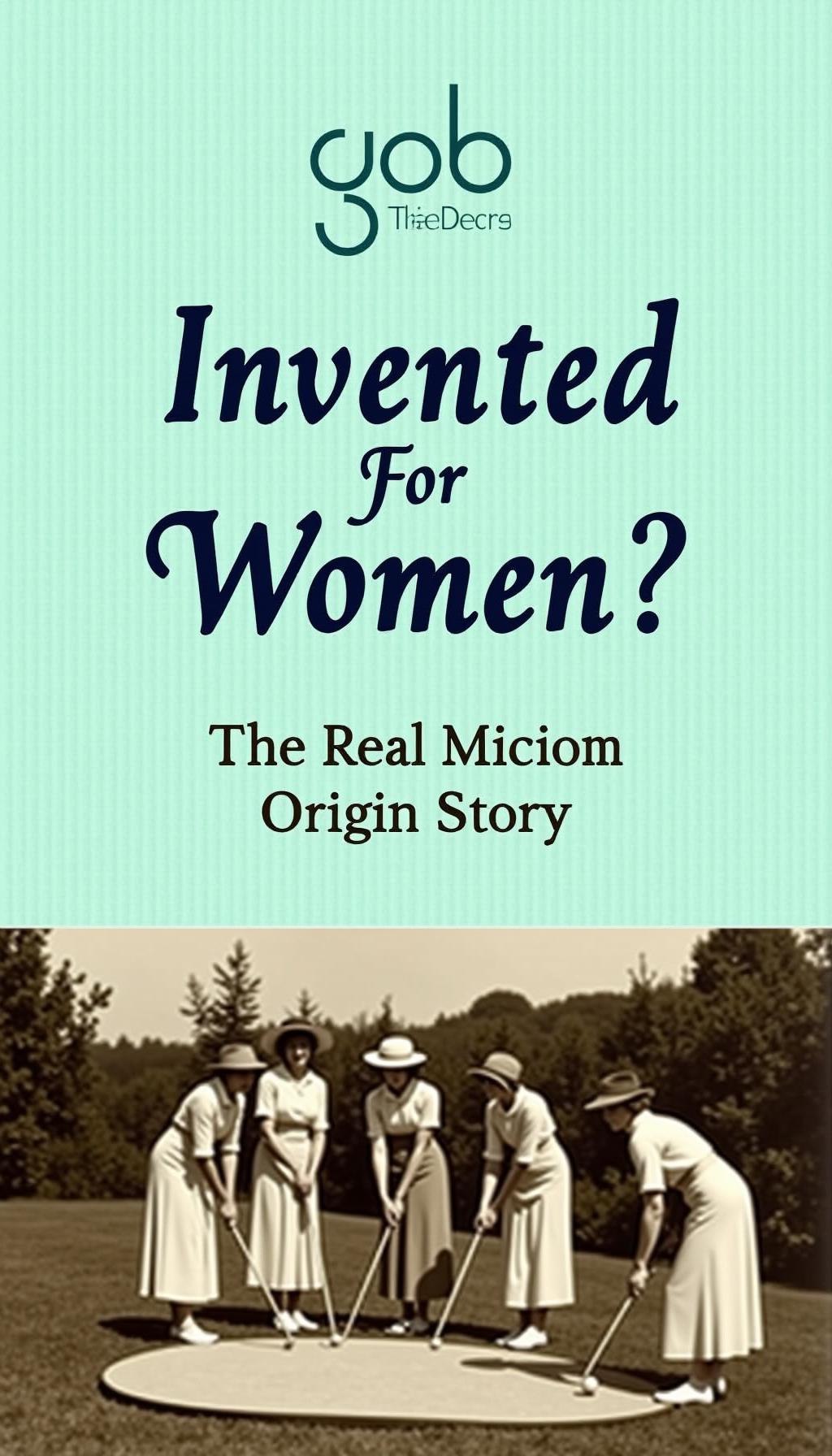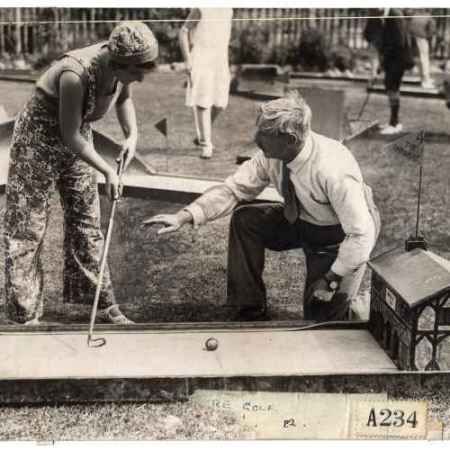As an Amazon Associate GolferHive.com earns from qualifying purchases.
Invented For Women? The Real Mini Golf Origin Story
If you’ve ever wondered who invented mini golf, you’ve stumbled upon one of the most debated and surprising origin stories in recreation. The common search for a single inventor often leads to confusion, with multiple names and dates clouding the real history. The truth is far more interesting than a simple invention; it’s a story of social change, creative engineering, and brilliant business savvy that unfolded over nearly a century.
The invention of mini golf cannot be attributed to a single person; it evolved over decades through the contributions of several key figures and innovators. This complex history spans from a private putting green for women in 19th-century Scotland to a nationwide craze fueled by franchised, whimsical courses in 1920s America.
This guide unpacks the complete, data-driven story of who invented mini golf, moving beyond the myths to reveal the true pioneers. Leveraging extensive analysis of historical records, we will trace the evolution of the game from its earliest precursor to the two distinct styles—serious sport and wacky fun—that we know and love today. You’ll discover the critical innovations and key players who each laid a stone on the path to creating this beloved pastime.
Key Facts
- No Single Inventor: Historians agree that mini golf was not the creation of one individual but rather an evolution, with multiple people contributing key innovations over many decades.
- Scottish Origins for Women: The earliest known precursor to a miniature golf course was created in 1867 in St. Andrews, Scotland, specifically for women who were barred from full golf swings due to restrictive social norms of the era.
- First Standardized U.S. Course: The first recognized, standardized miniature golf course in the United States, named “Thistle Dhu,” was built in 1916 on a private estate in Pinehurst, North Carolina.
- The Commercial Boom: The game’s explosion in popularity is credited to Garnet Carter, who patented and, most importantly, franchised his “Tom Thumb Golf” concept in 1927, leading to thousands of courses being built nationwide.
- “Putt-Putt” Is a Brand, Not a Synonym: Don Clayton founded the “Putt-Putt” brand in 1954, which is a trademarked, skill-focused version of the game with metal rails and par-2 holes, distinct from generic “miniature golf.”
The Big Question: Who Actually Invented Mini Golf?
The invention of mini golf cannot be attributed to a single person; it evolved over decades through the contributions of several key figures and innovators. While many people ask who invented mini golf hoping for a single name, the reality is a fascinating journey through time. The history is debated among historians, but a clear timeline of influence emerges when you connect the dots. The game we play today is a blend of ideas from different eras, each building upon the last.
To truly understand the origin of mini golf, we need to look at the key moments and people who shaped it. This isn’t a story about one inventor but a collection of pioneers who each added a crucial piece to the puzzle.
- The Scottish Precursor: Where a putting-only game was created out of social necessity.
- The First U.S. Courses: When the idea crossed the Atlantic and became a designed, landscaped experience.
- The Commercial Boom: How key inventions and a brilliant business model turned a niche hobby into a national craze.
- The Modern Divergence: The split into the serious, skill-based game and the wacky, obstacle-filled amusement we recognize today.
So if one person didn’t invent it, who were the pioneers that shaped the game we play today? Let’s trace the history.
Was Mini Golf Invented for Women? A Look at its Scottish Roots
The earliest known miniature golf course was created in 1867 for The Ladies’ Putting Club of St. Andrews, Scotland, because social norms deemed a full golf swing “unladylike” for women. This is the first verifiable answer in the long history of the question, who invented mini golf. At a time when women were largely excluded from the main golf links, this special course provided an outlet for them to participate in the sport in a socially acceptable manner.

The primary reason for this separation was the prevailing Victorian-era view on etiquette and physical activity for women. A full, powerful golf swing was considered improper and ungraceful.
The social norms of the 19th century considered the act of a full golf swing, which required raising the club above shoulder height, to be “unladylike.” This restriction effectively barred women from playing on traditional golf courses alongside men.
This led to the creation of a unique, putting-only course at St. Andrews, the very home of golf. This course, known as “The Himalayas”, was established in 1867 for The Ladies’ Putting Club of St. Andrews. It featured natural undulations and challenging slopes but was designed exclusively for the short game, eliminating the need for a full swing. This focus on putting is the foundational element that connects this early course to the mini golf we know today.
Quick Fact: This course, known as ‘The Himalayas,’ is often cited as the oldest miniature golf course in existence and was designed purely for putting.

The First Standardized Course in the U.S.: James Barber’s “Thistle Dhu”
In 1916, James Barber built “Thistle Dhu” in Pinehurst, NC, considered the first standardized miniature golf course in the U.S., featuring designed obstacles and artificial greens. While Scotland laid the groundwork, the next major leap in the story of who invented mini golf happened on American soil. James Barber, an English shipping magnate living on a lavish estate in Pinehurst, North Carolina, created a course that would become the blueprint for future designs.
His course was named “Thistle Dhu” (a play on “This’ll Do”), a charming and humble name for what was a remarkably ornate creation. Unlike the natural putting greens of Scotland, Thistle Dhu was a fully designed experience. As documented in publications like The Illustrated London News, it was a true game-changer.
The key features that set Thistle Dhu apart and influenced the future of mini golf included:
1. Artificial Greens: Moving away from simple grass, Barber utilized specially prepared surfaces for consistent putting.
2. Elaborate Landscaping: The course was integrated into its environment with beautiful gardens and aesthetic elements.
3. Designed Obstacles: It featured intentional challenges, including fountains and geometric patterns that players had to navigate.
4. Standardized Layout: It was a full 18-hole course, establishing a format that would become an industry standard.
Imagine being a guest at this lavish estate in 1916 and seeing this intricate, garden-like putting course for the first time. It was a world away from a simple lawn. This course proved that miniature golf could be more than just practice putting; it could be a unique, stand-alone game of skill and design.

The Tipping Point: How Visionaries in the 1920s Created a Craze
Garnet Carter commercialized and popularized mini golf by patenting and franchising his “Tom Thumb Golf” courses in 1927, leading to a nationwide boom enabled by Thomas Fairbairn’s earlier invention of an artificial green surface. The 1920s were the decade when mini golf went from a private pastime for the wealthy to a full-blown national obsession. This explosion wasn’t the work of one man but the result of two crucial innovations that happened just a few years apart. Answering who invented mini golf in its popular form requires looking at both the engineer and the entrepreneur.
First came the technical breakthrough. In 1922, Thomas McCullough Fairbairn, a golf enthusiast, created a durable, all-weather artificial green. His mixture of cottonseed hulls, sand, oil, and dye was revolutionary. It allowed courses to be built anywhere, from city rooftops to indoor spaces, and they could withstand heavy foot traffic and rain.
Then came the business mastermind. In 1927, Garnet Carter, a hotel owner on Lookout Mountain, Tennessee, saw the commercial potential. He created a miniature golf course with whimsical, fairy-tale themes to entertain guests at his hotel. He patented his version as “Tom Thumb Golf” and, most importantly, began to franchise the concept. Carter’s company mass-produced the courses, complete with obstacles like hollowed-out logs and tunnels, and sold them to entrepreneurs across the country. By the late 1920s, tens of thousands of these courses dotted the American landscape.
Here’s how their contributions created the perfect storm for the mini golf craze:
| Innovator | Key Contribution | Impact on Mini Golf |
|---|---|---|
| Thomas McCullough Fairbairn (1922) | Invented an artificial green from cottonseed hulls, sand, and oil. | Made courses accessible, durable, and playable in any weather. |
| Garnet Carter (1927) | Patented and franchised “Tom Thumb Golf” with whimsical themes. | Sparked a nationwide boom, creating tens of thousands of courses. |
Pro Tip: While many people built courses, it was Garnet Carter’s business savvy in franchising his ‘Tom Thumb Golf’ that turned a pastime into a national obsession.
Modern Mini Golf: From Serious Sport to Wacky Obstacles
Modern mini golf split into two paths: Don Clayton’s skill-focused, trademarked “Putt-Putt” (1954) emphasizing precision, and the Lomma brothers’ revival of whimsical, animated obstacles like spinning windmills (1955). After the initial boom and a subsequent lull during the Great Depression, mini golf re-emerged in the 1950s and evolved into the two distinct styles we see today. The answer to who invented mini golf in its modern forms depends entirely on which style you’re talking about.
This divergence created the two main philosophies of miniature golf that persist to this day, catering to different types of players.
- The “Serious Sport” Movement: In 1954, Don Clayton founded Putt-Putt in Fayetteville, North Carolina. His vision was to strip away the luck and whimsy and create a game of pure skill. He established a trademarked brand with a strict set of rules: courses featured geometric layouts, metal rails for bank shots, and a standard of par-2 on every hole. Clayton wanted to make miniature golf a serious, competitive sport, and “Putt-Putt” remains a distinct, skill-based game. It’s crucial to note that Putt-Putt is a trademarked name and not a generic term for all mini golf.
-
The “Wacky Fun” Revival: Just one year later, in 1955, Al and Ralph Lomma of Lomma Golf, Inc., took mini golf in the opposite direction. They are credited with bringing back and popularizing the animated, “wacky” obstacles that had fallen out of favor. Their innovations included the iconic spinning windmill blades, revolving statues, and other trick hazards that required timing and a bit of luck to overcome. This style embraced the fun and amusement park-like atmosphere that many people now associate with a classic game of mini golf.
https://m.youtube.com/watch?v=uge5Y_d8Rss&pp=ygUJI2dvbHBsYWNl
Which do you prefer? The precision and skill of Putt-Putt, or the unpredictable fun of a ball-eating castle and a spinning windmill?
Whether you’re looking to practice your short game or just have some fun with friends and family, having the right equipment can make all the difference. A quality putter set can help you start your own backyard course or simply improve your score on your next outing.
FAQs About the Invention of Mini Golf
To clear up some common points of confusion, here are direct answers to the most frequently asked questions about the history of mini golf.
So, who is the one person credited with inventing mini golf?
No single person is credited as the sole inventor. The game evolved from the contributions of many individuals over several decades. Historians recognize it as a progression, starting with The Ladies’ Putting Club in Scotland (1867), moving to James Barber’s standardized course in the U.S. (1916), and exploding in popularity thanks to Garnet Carter’s franchising model (1927).
Was mini golf invented in Chattanooga?
No, but Chattanooga (specifically Lookout Mountain, TN) is where Garnet Carter created and first franchised his popular “Tom Thumb Golf” courses, leading to the game’s nationwide boom. While the very first courses were elsewhere, Chattanooga played a pivotal role in transforming mini golf from a niche hobby into a commercially successful and widespread phenomenon in the late 1920s.
Who started Putt-Putt?
Don Clayton founded the Putt-Putt brand in 1954, creating a version of miniature golf focused on skill with par-2 holes and metal rails. He aimed to establish a serious, competitive sport distinct from the more whimsical mini golf courses. “Putt-Putt” is a trademarked brand and a specific style of play, not a generic term for the game.
What is the oldest miniature golf course?
The “The Himalayas” course at The Ladies’ Putting Club of St. Andrews in Scotland, created in 1867, is widely considered the oldest known miniature golf course. It was designed as a putting-only course for women who were restricted by social norms from playing on the main golf links.
Final Summary: The Evolving Story of Mini Golf
The question of who invented mini golf doesn’t have a simple answer because the game was never truly invented by just one person. Instead, it was shaped, refined, and reinvented over a century by a series of innovators who each saw a new possibility in the simple act of putting a ball into a hole. From a course born of social restrictions in Scotland to a nationwide American craze and its eventual split into a serious sport and a wacky amusement, mini golf’s history is as rich and varied as the courses themselves.
It’s a story of evolution, not a singular event. Each pioneer laid a foundation for the next, resulting in the beloved global pastime we enjoy today.
- The Social Precursor: Started in Scotland (1867) as a putting-only game for women.
- The U.S. Blueprint: Standardized by James Barber (1916) with designed courses.
- The Commercial Boom: Popularized and franchised by Garnet Carter (1927).
- The Modern Divergence: Evolved into skill-based Putt-Putt (Don Clayton, 1954) and wacky-obstacle courses (Lomma Bros, 1955).
The next time you line up a putt past a windmill, you’ll know you’re taking part in a pastime with a rich and surprising history
Last update on 2025-12-07 / Affiliate links / Images from Amazon Product Advertising API

